In the fast-paced, high-stress corporate world, the need for dedicated spaces that foster mental well-being and mindfulness has never been more apparent. As employers recognize the importance of workplace wellness initiatives, the integration of meditation rooms within office environments has become a growing trend. This comprehensive guide explores the concept of creating peaceful meditation room office spaces, addressing the benefits, design considerations, and implementation strategies to help cultivate a tranquil, productivity-boosting sanctuary for employees.
Key Takeaways
- Understand the rise of workplace wellness initiatives and the need for dedicated meditation spaces
- Explore the benefits of meditation rooms, including their impact on employee mental health and productivity
- Discover essential elements for creating a tranquil office meditation space
- Learn how to choose the perfect location for your office Zen corner, considering noise, space, and natural light factors
- Dive into the role of color psychology, biophilic design, and thoughtful furniture selection in meditation room office spaces
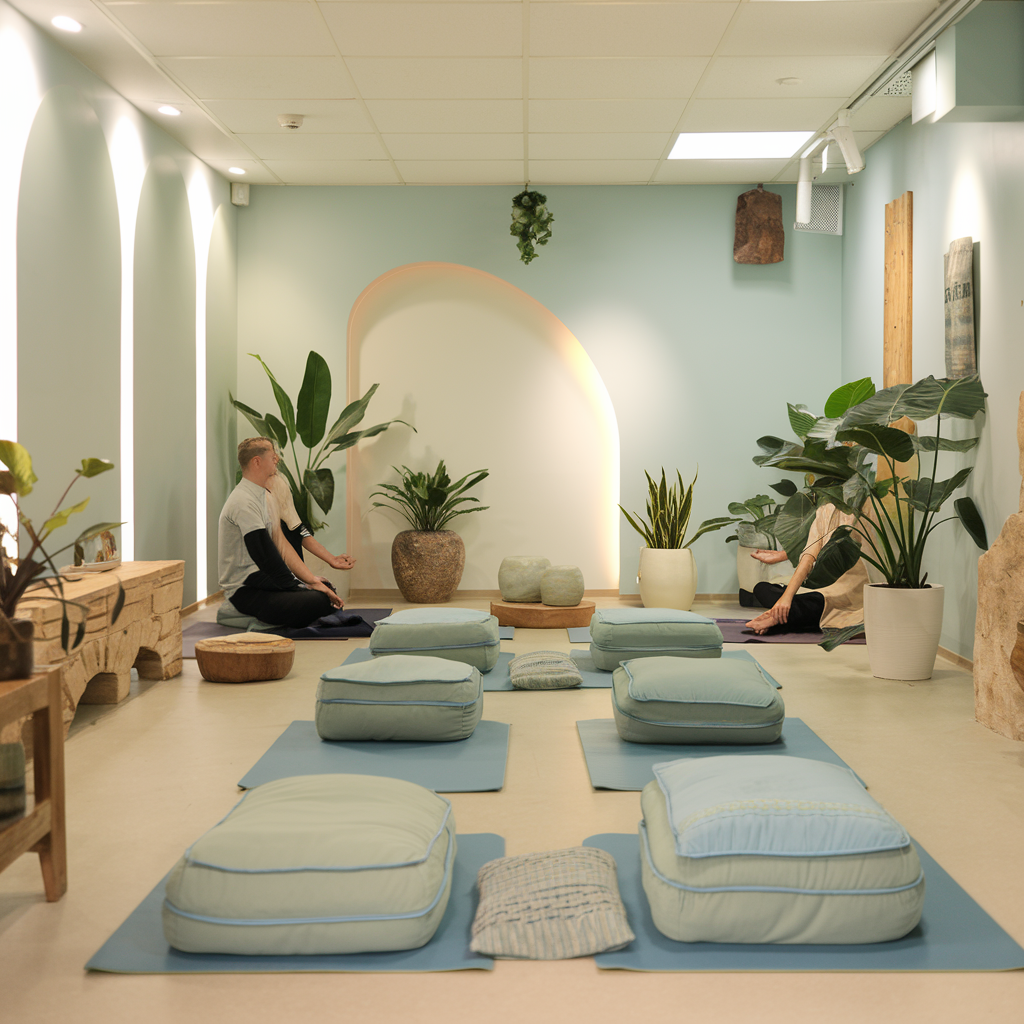
Understanding the Need for Meditation Room Office Spaces
As workplace wellness initiatives gain momentum, the demand for dedicated meditation zones within office environments is on the rise. These mindfulness zones provide employees with a serene sanctuary to recharge, reflect, and rejuvenate during the workday. The growing emphasis on employee serenity zones underscores the crucial role of mental well-being in fostering a thriving and productive workplace wellness culture.
The Rise of Workplace Wellness Initiatives
Pioneering companies have recognized the importance of supporting their employees’ holistic well-being. Through the implementation of comprehensive workplace wellness programs, these forward-thinking organizations are investing in their most valuable asset – their people. From on-site fitness facilities to mindfulness workshops, these initiatives aim to create a work environment that nourishes both physical and mental health.
Benefits of Dedicated Meditation Spaces
- Reduced stress and anxiety levels
- Improved focus, concentration, and productivity
- Enhanced creativity and problem-solving abilities
- Stronger sense of work-life balance and job satisfaction
Impact on Employee Mental Health
The availability of dedicated meditation room office spaces has a profound impact on employee mental health. By providing a peaceful and distraction-free environment, these mindfulness zones offer a much-needed respite from the fast-paced and often overwhelming nature of modern work life. Employees who regularly utilize these spaces report feeling more grounded, centered, and resilient, ultimately leading to improved overall well-being and job performance.
“Investing in employee mental health through the creation of dedicated meditation spaces is not only the right thing to do, but it also yields tangible benefits for the organization as a whole.”
Essential Elements of a Tranquil Office Meditation Space
Creating a tranquil and serene meditation space within the office environment is crucial for fostering a sense of calm and mindfulness among employees. To establish an effective office zen corner, there are several essential elements to consider:
First and foremost, the ambiance of the space is paramount. Neutral, earthy tones and natural materials like wood, stone, or plants can help cultivate a relaxation spaces that feels grounded and soothing. Soft, indirect lighting and the strategic placement of tranquil workspaces can further enhance the meditative atmosphere.
Comfortable, ergonomic seating options are a must for enabling employees to truly immerse themselves in their mindfulness practices. Plush cushions, ottomans, or even yoga mats can provide the necessary support for extended periods of sitting or lying down.
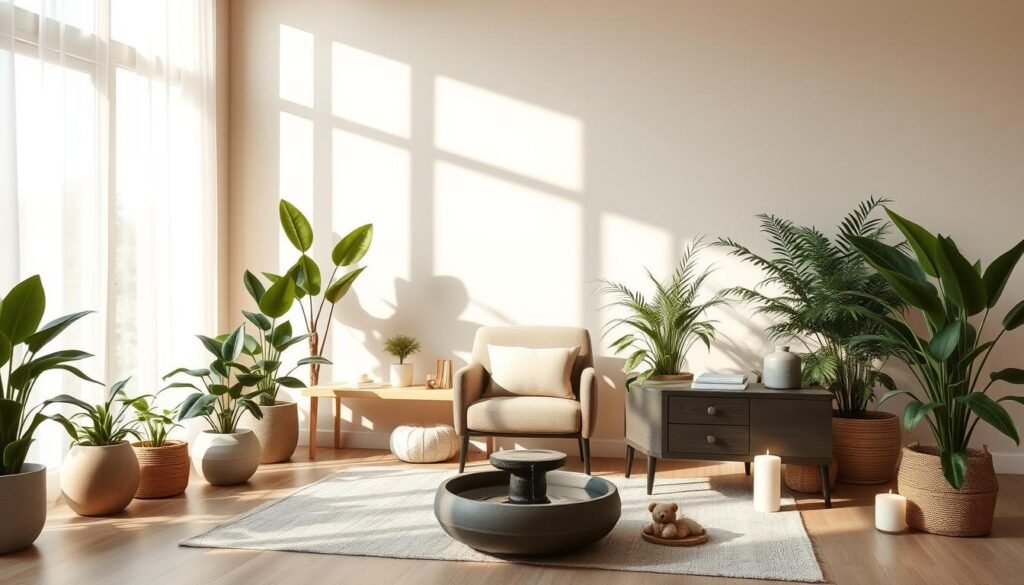
The incorporation of sensory elements, such as the gentle sound of a water feature or the calming aroma of essential oils, can help office zen corners become a true sanctuary for relaxation and rejuvenation. Tactile elements, like smooth river stones or natural fabrics, can also contribute to a soothing, grounding experience.
By thoughtfully designing and curating these essential elements, organizations can create tranquil workspaces that empower their workforce to unlock the benefits of mindfulness and wellness practices, ultimately leading to improved focus, productivity, and overall well-being.
Choosing the Perfect Location for Your Office Zen Corner
In the quest to create a soothing and tranquil office zen corner, the location of your dedicated meditation space is of utmost importance. By carefully considering factors like noise levels, accessibility, and natural light, you can establish a true workplace calm sanctuary that helps your employees recharge and rejuvenate.
Noise Considerations and Sound Insulation
The success of your quiet rooms hinges on minimizing disruptive sounds and external noise. Prioritize locations that are naturally shielded from high-traffic areas, loud machinery, or bustling office chatter. Incorporate sound-absorbing materials, such as acoustic panels or plush furnishings, to further enhance the audio privacy and serenity of your office zen corner.
Space Requirements and Accessibility
Ensure that your workplace calm sanctuary is strategically located and easily accessible to all employees. Allocate a comfortable and inviting space that can accommodate individual or group meditation sessions without feeling cramped or overcrowded. Consider factors like foot traffic patterns and proximity to other wellness amenities to make your quiet rooms a convenient and inclusive retreat.
Natural Light and Ventilation Factors
Harnessing the restorative power of nature is a key element in creating a truly tranquil office zen corner. Seek out areas with abundant natural light, as it can have a profound impact on mood, focus, and overall well-being. Likewise, ensure proper ventilation to maintain a fresh, rejuvenating ambiance within your workplace calm sanctuary.
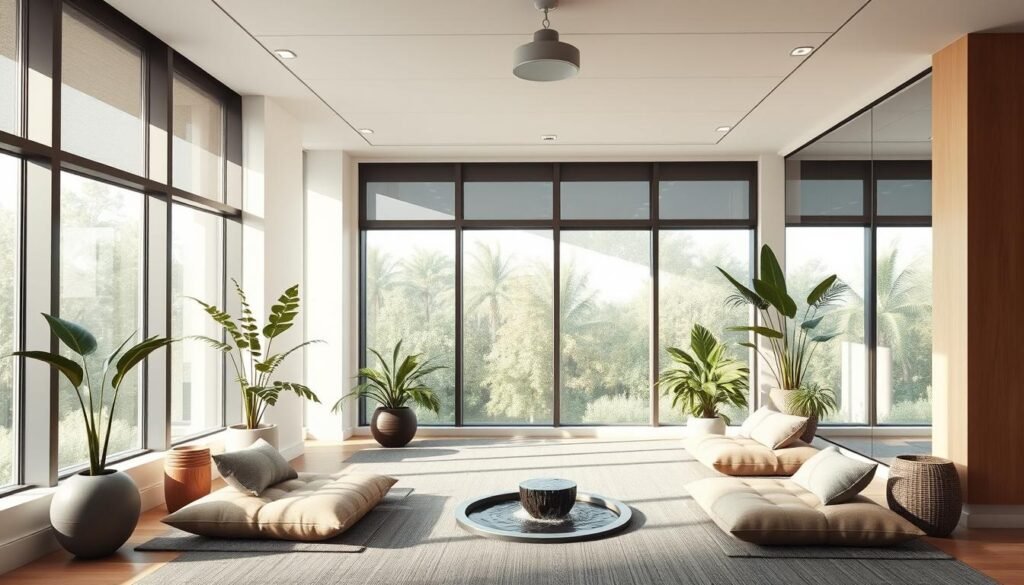
“The best meditation spaces are those that seamlessly blend the indoor and outdoor environments, allowing employees to connect with the natural world and find their center of balance.”
Designing with Color Psychology and Mindful Aesthetics
When creating tranquil workspaces and meditation room office spaces, the strategic use of color and mindful aesthetics plays a crucial role in cultivating a truly calming and restorative environment. Color psychology, the study of how different hues impact our emotions and behaviors, offers invaluable insights for designing soothing mindfulness zones.
Soft, muted tones like blues, greens, and neutrals are particularly effective in promoting a sense of serenity and relaxation. These colors have a naturally calming effect, helping to lower stress levels and encourage deeper focus during meditation or mindfulness practices. In contrast, vibrant, intense colors can be overstimulating, disrupting the peaceful ambiance essential for meditation room office spaces.
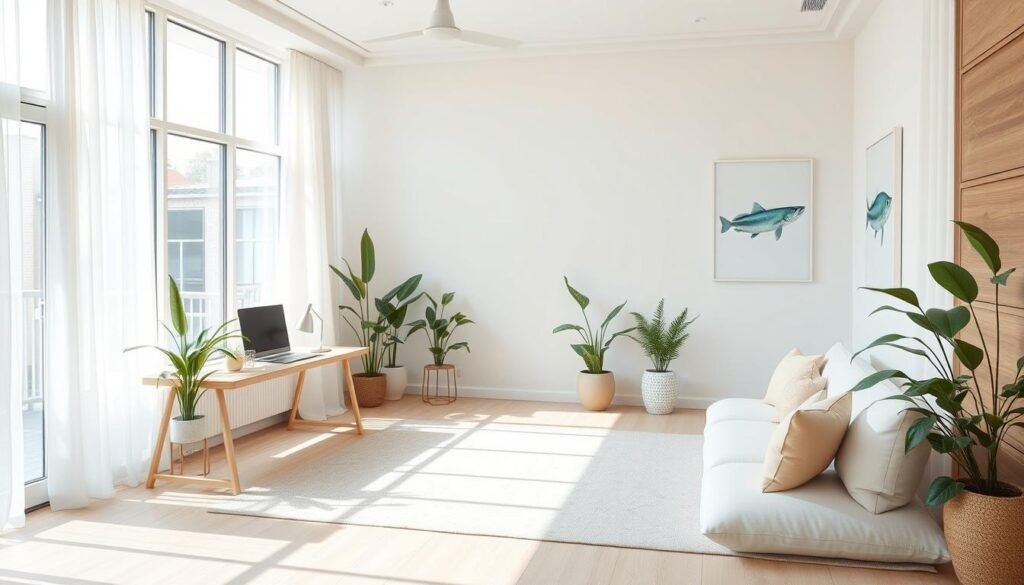
Beyond color, the overall aesthetic of the space should embody a sense of simplicity and balance. Clean lines, natural materials, and minimal decorative elements create a visually calming environment that aligns with the principles of mindfulness. Carefully curated artwork, plants, and textures can further enhance the tranquil atmosphere, inspiring introspection and a deeper connection with the present moment.
By thoughtfully incorporating color psychology and mindful design elements, businesses can cultivate tranquil workspaces that nurture employee well-being, boost productivity, and foster a culture of mindfulness within the organization.
Furniture Selection for Meditation Room Office Spaces
When creating relaxation spaces and corporate wellness areas within your office, the furniture selection plays a crucial role in cultivating an atmosphere of serenity and employee serenity. From comfortable seating options to efficient storage solutions, the right furniture choices can transform your meditation room into a tranquil haven for your team.
Comfortable Seating Options
The centerpiece of any meditation room is the seating arrangement. Opt for ergonomic, cushioned chairs or meditation pillows that promote proper posture and support during extended sessions. Plush, floor-level seating, such as zafu cushions, can also be a welcoming addition, catering to a variety of relaxation practices.
Storage Solutions
Incorporate discreet storage units to house meditation props, aromatherapy diffusers, and other wellness accessories. Streamlined shelves or cabinets can keep your employee serenity zone organized and clutter-free, allowing your team to fully immerse themselves in the experience.
Versatile Layout Arrangements
Design your meditation room with a flexible layout that can accommodate individual practice, group sessions, or even corporate mindfulness workshops. Modular furniture, such as movable ottomans or reconfigurable seating, can help you adapt the space to your evolving needs and preferences.

By thoughtfully selecting the right furniture for your corporate wellness areas, you can create a soothing, comfortable, and functional meditation room that will enhance your employees’ well-being and productivity.
Incorporating Natural Elements and Biophilic Design
Creating tranquil workspaces and office zen corners requires a thoughtful integration of natural elements that promote a sense of workplace calm and wellness. Biophilic design, the practice of incorporating nature-inspired features into built environments, plays a crucial role in enhancing the overall ambiance of meditation room office spaces.
One of the key aspects of biophilic design is the use of natural materials, such as wood, stone, and plants. These organic elements not only contribute to the aesthetic appeal of the space but also have a calming effect on the senses. By incorporating natural textures and patterns, you can foster a stronger connection between the indoor and outdoor environments, creating a sense of tranquility and balance.
In addition to physical elements, the incorporation of natural light is another essential aspect of biophilic design. Allowing sunlight to flood the meditation room office space can have a profound impact on mood, productivity, and overall well-being. Strategically placed windows, skylights, or even light-reflecting surfaces can help to create a soothing, luminous atmosphere that encourages relaxation and mindfulness.
Another way to bring the outdoors in is through the introduction of living plants. Studies have shown that the presence of greenery can have a positive effect on mental health, reducing stress and promoting a sense of calm. By carefully selecting and arranging plants, you can create a lush, verdant oasis within the workplace, providing a tranquil refuge for employees to recharge and rejuvenate.
By embracing the principles of biophilic design, you can transform your office zen corners into truly restorative and tranquil workspaces that support the mental well-being of your employees. This holistic approach to workplace design not only enhances the aesthetic appeal of the space but also contributes to a healthier, more productive work environment.
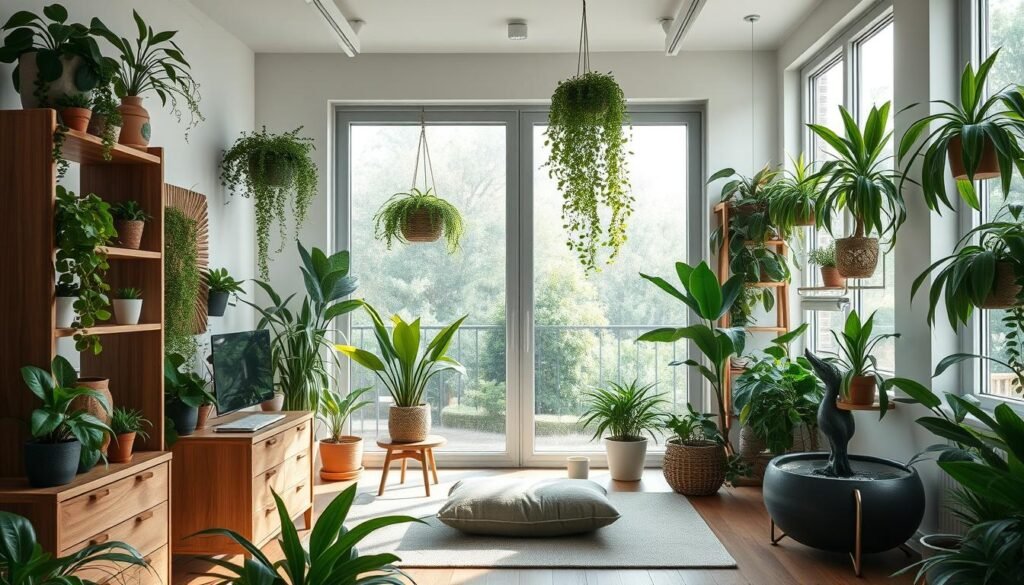
| Key Biophilic Design Elements | Benefits |
|---|---|
| Natural Materials (wood, stone, plants) | Calming sensory experience, connection to nature |
| Natural Light | Improved mood, productivity, and well-being |
| Living Plants | Stress reduction, enhanced mental health |
“Biophilic design is not just about incorporating natural elements; it’s about creating a deep, emotional connection between people and the natural world.”
Lighting Solutions for Corporate Wellness Areas
Creating a serene and productive meditation room in an office setting requires careful consideration of the lighting design. The balance between natural and artificial light plays a crucial role in establishing the right ambiance for employee serenity zones and quiet rooms.
Natural vs. Artificial Light Balance
Harnessing the power of natural daylight is essential for fostering a calming and rejuvenating atmosphere. Ample windows and skylights allow sunlight to flood the meditation room office spaces, promoting a connection with the outdoors and enhancing the overall sense of tranquility. However, it’s essential to balance this natural light with strategically placed artificial lighting to ensure a comfortable and consistent illumination throughout the day.
Dimming Options and Controls
- Incorporate dimmable lighting fixtures that allow employees to adjust the brightness based on their individual needs and preferences.
- Implement smart lighting controls, such as motion sensors or timers, to automatically adjust the lighting levels throughout the day, ensuring the meditation room remains well-lit yet soothing.
- Provide easy-to-use dimming controls that allow users to customize the lighting to suit their meditation or relaxation practices.
Mood-enhancing Lighting Techniques
Thoughtful lighting design can significantly contribute to the overall mood and ambiance of the corporate wellness area. Consider incorporating soft, indirect lighting fixtures that cast a warm, diffused glow, creating a calming and inviting atmosphere. Strategically placed accent lighting can also highlight specific features or zones within the meditation room, such as a cozy seating nook or a tranquil water feature.
| Lighting Technique | Benefits |
|---|---|
| Layered Lighting | Combines ambient, task, and accent lighting to create a visually interesting and versatile space |
| Color Temperature Adjustment | Allows users to adjust the color temperature of the lighting to suit their mood and preferences |
| Circadian Rhythm Lighting | Synchronizes lighting with the natural daylight cycle to support employees’ natural sleep-wake patterns |
By carefully curating the lighting solutions for corporate wellness areas, organizations can create meditation room office spaces that promote relaxation, focus, and overall employee well-being.
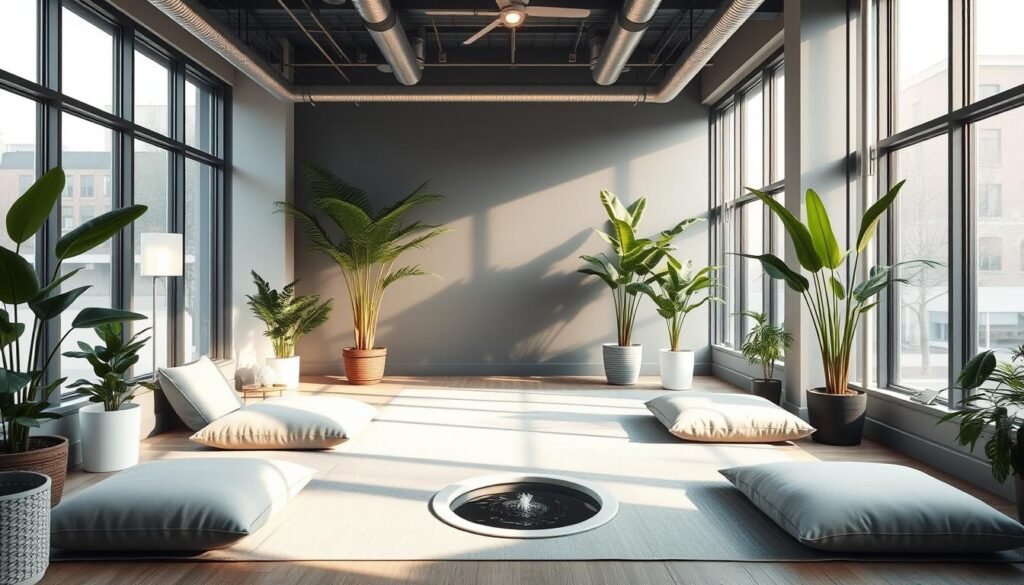
Maintaining and Managing Your Workplace Calm Sanctuary
Cultivating a peaceful and tranquil meditation room within the office space is just the beginning. To ensure the longevity and effectiveness of your workplace calm sanctuary, it’s crucial to establish a comprehensive maintenance and management strategy. Regular cleaning schedules, well-defined usage guidelines, and continuous updates will help preserve the serenity and appeal of this dedicated wellness area.
Cleaning and Maintenance Schedules
Keeping the meditation room pristine and inviting requires a thoughtful cleaning and maintenance regimen. Designate a team member or a contracted cleaning service to handle regular dusting, vacuuming, and sanitization tasks. Establish a schedule that balances the needs of the space with minimal disruption to employees’ meditation routines.
Usage Guidelines and Policies
Implementing clear usage guidelines and policies will help ensure the meditation room remains a calm and respectful sanctuary for all employees. Clearly communicate rules around reserving the space, noise levels, and appropriate behaviors. Encourage users to maintain the tranquility of the environment and respect the needs of their fellow colleagues.
Regular Updates and Improvements
To sustain the appeal and effectiveness of the workplace calm sanctuary, regularly review and update the space. Solicit feedback from employees, monitor usage patterns, and make adjustments to the design, furnishings, or amenities as needed. Embrace innovative ideas and stay attuned to emerging trends in corporate wellness to continuously enhance the meditation room’s ability to support employee well-being.

Hello, I’m Jane, founder of Home Vibe Ideas. I’m here to inspire stylish Home Design, modern Smart Living, beautiful Outdoor Spaces, and creative DIY Projects to help you create a home that’s uniquely yours.
Disclosure: This post contains affiliate links. If you click on a link and make a purchase, we may earn a small commission at no additional cost to you. The content on this site was created with the help of AI technology.


